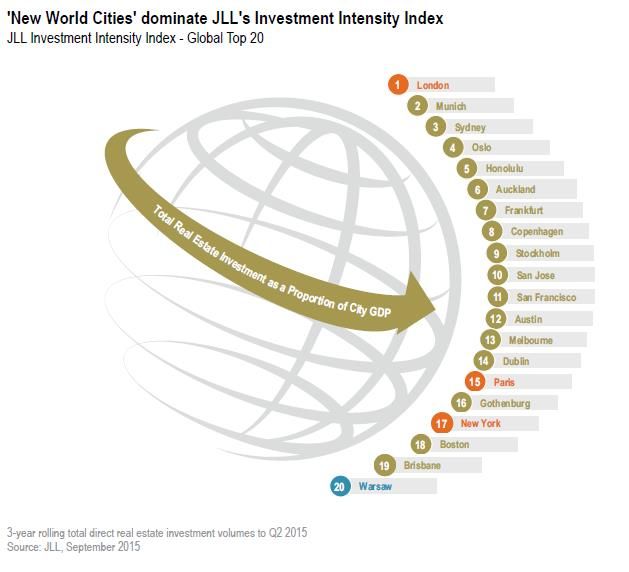
The old concept of a global city hierarchy is being replaced by the concept of city clusters and systems of cities
Established World Cities’ remain dominant commercially but face stiff competition and tough growth challenges
Several ‘Emerging World Cities’ break from the pack and are on a fast track to maturity
Mid-sized, globally specialised ‘New World Cities’ are drawing capital, corporations and talent
LONDON, 4 November 2015 – New research from JLL (NYSE:JLL) in conjunction with The Business of Cities reveals that the old world order and the traditional hierarchy of cities is breaking down. Globalisation, urbanisation and technological advancement, alongside a deeper understanding of what makes cities competitive and attractive, has forced a major shift in the world’s urban commercial geography. The report, ‘Globalisation and Competition: The New World of Cities’ explains how this is resulting in an evolution of new types, styles and clusters of cities, which will significantly change the future geography of real estate investment.
Greg Clark, Chairman of The Business of Cities and of the JLL Cities Research Centre said: “Cities globally are undergoing a metamorphosis in the face of rapid urbanisation, technological disruption and new models of commerce. Cities everywhere are seeking innovative approaches to seize opportunities and tackle challenges to ensure they become and remain sustainable, competitive and liveable.”
JLL’s report groups global cities into three broad categories
The New World Cities are an evolving group of cities that are redefining what it means to be global. Typically mid-sized, they have strong technology credentials, are highly liveable with favourable infrastructure and are often supported by global specialisms. Archetypal new world cities include Munich, Boston and Brisbane. These cities are attracting talent and corporations as well as a disproportionate share of global real estate investment. JLL predicts that these cities will be at the forefront of innovations in real estate, living and work styles by virtue of creating urban development models which are smart, sustainable and resilient.
The Emerging World Cities, given their long-term growth opportunities, are attracting increasing volumes of real estate activity, but the rise of these ‘Emerging World Cities’ is uneven. Shanghai and Beijing, as well as Istanbul, Taipei and Kuala Lumpur are fast tracking to maturity, but others are struggling to keep up with the pace of change.
The Established World Cities, notably the ‘Big Six’ of New York, Tokyo, London, Paris, Hong Kong and Singapore will maintain their dominance, but will need to execute bold and ambitious urban transformation projects to accommodate growth and maintain their global competitiveness.
These categories of cities are not static or mutually exclusive. Some cities are ‘Hybrids,’ like Dubai, Shenzhen, Bangalore, Buenos Aires, and Santiago, which have many of the characteristics of ‘Emerging World Cities,’ but are displaying the agility and value-creation of ‘New World Cities’ and as a result are cities to watch. Singapore, Berlin and Toronto and have the characteristics of being both Established World Cities and New World Cities. Seoul and Moscow are both Emerging World Cities and have many of the features of Established World Cities.
The real estate perspective Whilst the ‘Big Six’ Established World Cities account for more than one fifth of total global real estate investment activity, they will need to execute bold urban transformation plans (such as the ambitious ‘Grand Paris’ project) to support the shift to new modes of economic activity and to ensure the efficient recycling of land.
Emerging World Cities like Shanghai, Mexico City and Istanbul are witnessing massive expansion through the construction of impressive mixed-use schemes and trophy developments. But as these cities move to the next phase in their evolution, the real estate sector will play a more pivotal role in creating a ‘sense of place’ and contributing to city identity, uniqueness and well-being. As these are some of the world’s most environmentally challenged cities, real estate will be a key driver of more sustainable urban models. Improvements in real estate transparency also need to progress at much greater speed, not only to attract new capital, but to enhance the business operating environment and contribute to the quality of life of its citizens.
New World Cities are the home of many ‘millennials’; a demographic that demands less conventional real estate and has a preference for characterful properties and locations in vibrant mixed-use neighbourhoods. Real estate will play a particularly crucial role in building alliances between businesses, universities and civil society. ‘New World Cities’ are proving to be particularly attractive for real estate investors who are, either implicitly or explicitly, taking into consideration issues of liveability, sustainability and technological prowess in their strategic decision-making.
Rosemary Feenan, director of Global Research Programmes at JLL concluded: “This new economic and technological order offers cities the opportunity for re-invention, for the creation of a new economic and social dynamism, and improved quality of life. This new set of city clusters is carefully assessing how to capture and leverage those opportunities in ways that are consistent with their vision and with the realities of what is realistically deliverable. The result is that cities are redefining urban strategies and taking clear positions on the policies required to achieve their visons and style objectives. For real estate investors who are assessing and choosing cities to target, the move away from city hierarchies to these new clusters presents an opportunity to more readily identify very real future opportunities.”


